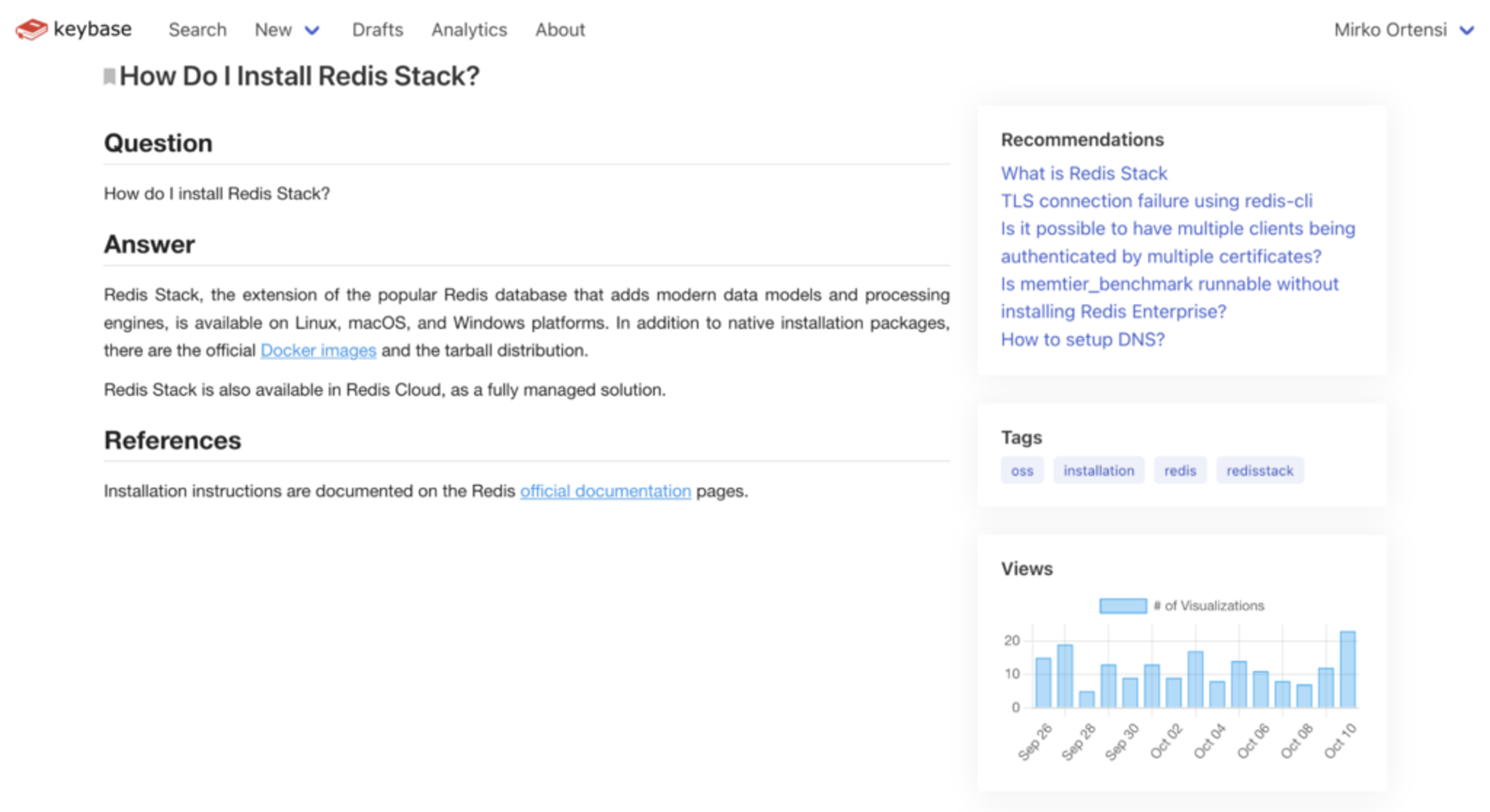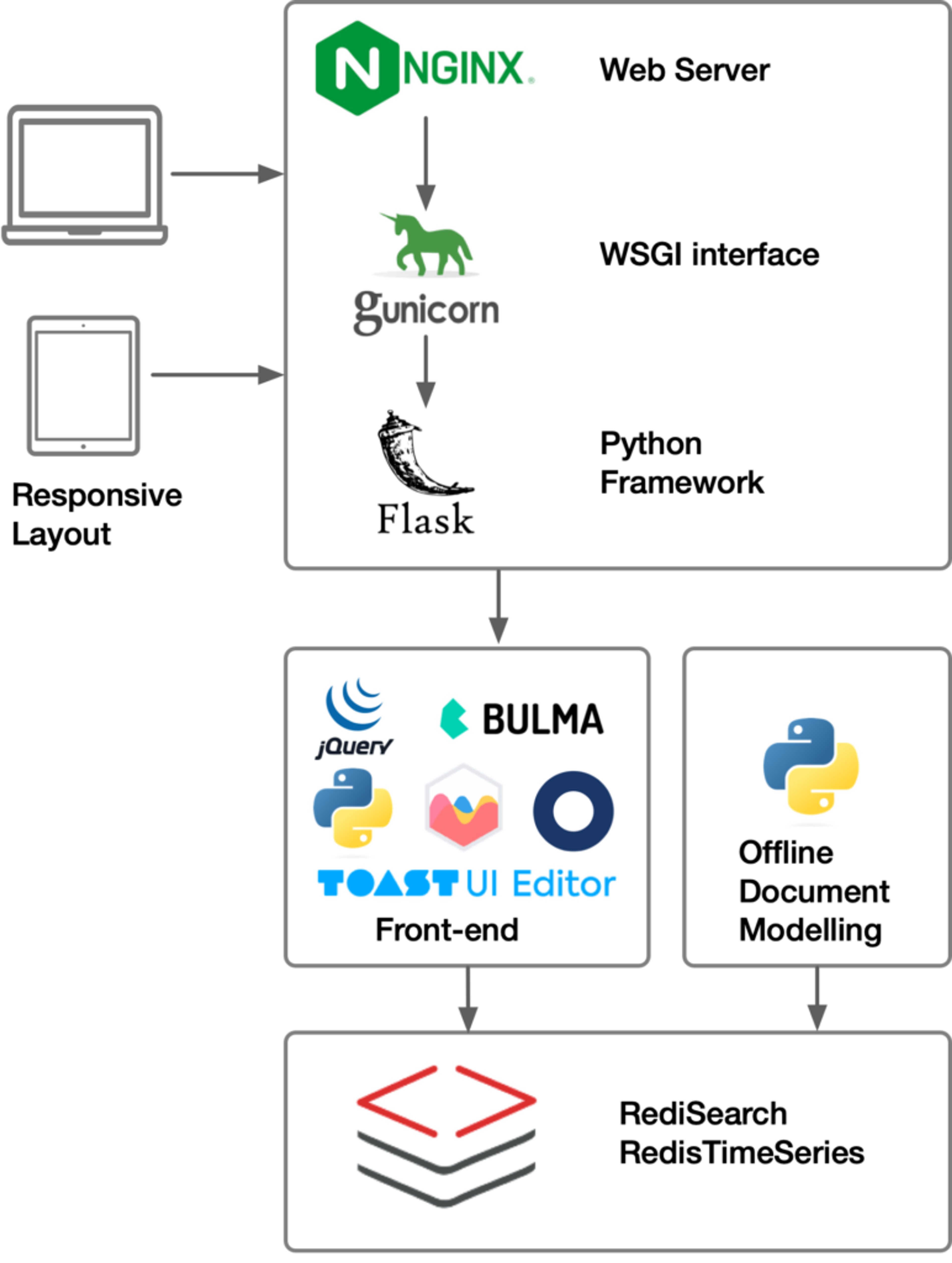Blog
How To Build a Knowledge Base Platform Using Redis
Building multi-model applications with Redis Stack is surprisingly straightforward! Follow along with a tutorial that shows how to build a knowledge base in Python that incorporates powerful search features.
Companies produce an overwhelming amount of data daily. It’s a huge challenge to organize it, filter out obsolete information, and make it available whenever it is needed. That is not a trivial problem.
Making sense of data is a different task than storing it. Accomplishing that goal includes documenting the data’s organization as well as the process by which it is created, edited, reviewed, and published, with awareness of the relationship between editors and consumers.
What are knowledge base systems, and why use them?
Knowledge base systems serve as libraries of information about a product, service, department, or topic. In such systems, documents are dynamic assets that can be referenced, improved, classified, shared, or hidden from unauthorized users. Typical examples include FAQ databases, how-to guides, and onboarding material for new hires. A knowledge base should be tailored to a company’s needs, which means it needs to interface with existing tools and processes.
The internet made knowledge base systems popular. Documents could be structured and connected using hypertext, the core idea behind the internet itself. Organizing and linking content in such a way changed forever the way producers and consumers would create value out of knowledge.
In this article, I demonstrate how to use Redis’s data structures and search capabilities to build a web knowledge base platform with basic functionality. This project is well suited to use Redis’s powerful capabilities for real-time full-text searches and queries because it fulfills the main purpose of such systems: providing several methods to retrieve the information a consumer is looking for and as soon as possible.
Keybase: a knowledge base project
This tutorial helps you build a knowledge base that can store and serve documents for typical use cases, such as customers who want to learn about a new product feature, troubleshoot a technical issue, or serve as a single, reliable source of truth for internal departments.
The project’s source codeis available in a GitHub repository, licensed under the MIT license.
I named this project “Keybase,” and this is a preview of what it looks like:

The components
In this tutorial, I use the following components to develop a working prototype:
- Redis Stack Server: This combines open-source Redis with RediSearch, RedisJSON, RedisGraph, RedisTimeSeries, and RedisBloom. Redis Stack also includes RedisInsight, a visualization tool for understanding and optimizing data stored in Redis
- Redis-py: A Python client library for Redis
- Flask: A lightweight Python web framework
- Toast UI web editor: A simple yet powerful WYSIWYG Markdown editor
- JQuery, JQueryUI, Notify.js, Chart.js: Javascript libraries and frameworks
- Bulma CSS framework: A CSS framework to build a fancy and responsive web interface
- Nginx and Gunicorn: The web server and the web server gateway interfaces that work with Flask
The architecture

The popular Nginx web server is used together with Gunicorn, which implements the web server gateway interface and serves the Flask application.
The knowledge base backend is implemented as a Python application developed over the popular Flask framework. Flask provides good separation among the views. The application is implemented using the Jinja template engine and the controllers delivered by the Werkzeug WSGI toolkit. User authentication is based on Okta, the popular Identity as a Service platform.
The front-end is styled using the CSS framework Bulma; JQuery is the Javascript library for Ajax communications and user interface manipulation together with JQueryUI, and Notify.js is used for UI notifications.
An additional service, deployed as a cron job, indexes documents for document similarity recommendations. Document indexing is conveniently decoupled from the sessions in order to avoid impacting the user experience.
Finally, in the data layer, the project uses a Redis database plus two Redis modules: RediSearch and RedisTimeSeries, which in the tutorial, I use for document indexation and search, and analytics, respectively.
The data model
Documents in the knowledge base are modeled as Hashes. Here is how the data is stored:
The Hash data structure stores:
- The document itself: the name and the content
- The document creation and update timestamps
- The state of the document: draft or published
- One or more tags for advanced searches
- The document’s owner (users own their private drafts)
- The flag processable, activated when the document is created or updated, lists documents to be reindexed for similarity search
- The field content_embedding stores the model of the document and is used for similarity search (discussed a little later)
Got all that? We’re ready to dive into the Keybase features and how to implement them.
Explore search features
We are extremely proud of the Redis database’s powerful real-time search features; this tutorial lets us show it off.
You probably think of search as a brute-force lookup, but in fact, there are no slow scans when we use RediSearch indexing capabilities. The options we cover briefly here are:
- Full-text search: returns documents that contain one or more keywords in the name and/or the content.
- Tag fields search: returns documents with a certain tag associated. Consider this to search for documents classified with certain attributes (e.g., documents tagged with the tutorial tag).
- Vector similarity search (VSS): returns documents that are similar to a specific document. Consider this when developing a recommendation system.
For a more in-depth explanation of search functionality in Redis, see an introduction to the RediSearch module.
RediSearch creates the index using this syntax:
The schema of the index document_idx enables the three types of search using the corresponding field types:
- TEXT enables the real-time full-text searches on the document name and its content (implemented via inverted indexes)
- TAG provides real-time querying capabilities to filter documents (such as by document state or a custom tag) and to sort the results by the creation or update timestamp
- VECTOR enables searches of similar documents using the vector stored by the attribute content_embedding
Full-text search
The search input field in the web interface is used to perform a full-text search, which looks at the name and content of the knowledge base documents.
Consider this example of a real-time full-text search using the redis-py client library. It performs the search on the query string received from the client. Note that this command excludes documents in draft state; such documents must be kept hidden and not included in the output:
This neat code sample performs a real-time full-text search and returns a batch of per_page documents starting from the specified offset (useful to paginate documents in the UI). It fulfills the search criteria specified: all the documents that satisfy the query the user provided in the input field, it removes the documents that are in draft state, and it sorts the documents by creation timestamp.
Tag fields search
An example of real-time querying by tag in Python, where the search is combined with the filter on the tag and also excludes documents that are in draft state, is the following, which returns all the documents tagged with the “troubleshooting” tag:
This snippet of code is a pure real-time query, including all the documents tagged using the troubleshooting keyword but also excluding those documents that are not public and still classified as private drafts. This syntax uses the indices on several fields in order to filter, order, and paginate the results.
Vector similarity search
You’re surely familiar with this sort of search, especially on e-commerce websites. Personalized recommendations direct users to similar content with prompts such as, “You may also be interested in reading” or “people who bought this also purchased. “
This sample application doesn’t need to increase product sales, as the knowledge base site has nothing to sell, but we do want to provide users with meaningful recommendations.
You can add recommendations using the VSS feature of Redis real-time search.
If you haven’t used this type of search in your projects, start with Rediscover Redis for Vector Similarity Search.
The short instructions: To use the VSS feature, you first create a model, then store it,and finally query it.
The core concept behind recommendations using VSS is to transform the document content into its corresponding vector embedding. The vector is the entity that describes the document and is compared against other vectors to return the best matches. The vector embedding is stored in the Hash data structure (in the content_embedding value).
In this example, we use the Python SentenceTransformer library to calculate the vector embedding using the all-distilroberta-v1 model (fromthe Hugging Face data science platform) as follows.
In this sample, the content of the document is vectorized and serialized in binary format, the format that VSS accepts. This operation is triggered twice: at document creation time and for any subsequent document update. In particular, when updating the document content, the vector embedding needs to be recalculated, or the index becomes obsolete and returns imprecise results. To trigger an offline vector embedding recalculation, as described in the architecture, it is sufficient to activate the processable flag and periodically list those documents whose vector embedding needs to be refreshed and then process them. For example:
Using the same syntax as in the previous tag search example, this command executes a search to include those documents with the tag processable set to 1. Documents returned by this search get the associated vector recalculated and stored.
Store the model
Once the vector embedding is generated, you can store it as usual in the document Hash data structure ((in the content_embedding field).
Finally, set the processable flag to zero. No further update is needed to the vector embedding until the next document change.
Perform the search
Every time the user sees a document, the sidebar proposes a list of recommendations. That means the Keybase application has to discover what the recommendations are.
To accomplish that, we fetch the vector embedding from the Hash of the document currently presented (that is, the one the user is looking at).
The hget returns the value associated with the field content_embedding.
To retrieve the most similar documents, compare the vector to the rest of the stored vectors.
In this example, the query is configured to execute the powerful vector similarity search to return the six most similar documents by retrieving the k-nearest neighbors (KNN).
For more VSS syntax examples, see the client library documentation.
Establish the knowledge base’s user data management
Every business application needs to establish who can and cannot access the software. For our knowledge base authentication, we use the popular Identity as a Service platform Okta. Users are stored in the Redis database as Hashes prefixed by the string “keybase:okta:”. I tested the integration with the Okta Developer Edition.
Here’s an example of a user profile:
To search the knowledge base users, we create an index on the user Hash data structures:
The group formalizes the implementation of Role-Based Access Control (RBAC). I created three user types for this example application, although additional roles can be added. The current roles are:
- Viewer: Typically, viewers can read, search, and bookmark documents
- Editor: Editors can create, edit, and tag drafts and submit them for review
- Admin: Administrators can publish documents or revert them to drafts, archive, and delete content. They also can administer the site, such as import and export data, and ban users.
Finally, it is also possible to bookmark documents by storing their IDs in a collection. Once more, the Hash is the best option because of its flexibility; you can store the document ID and also a personal comment on the bookmark.
Here’s an example of a collection for the authenticated user:
Use analytics to spot trends
Many business scenarios require the organization to monitor a knowledge base’s activity. For instance, you might want to evaluate document popularity by subject area, minimize repeated questions, or mine for new feature ideas.
The RedisTimeSeries capability is a natural choice for analytics functions because it is optimized to store and aggregate large amounts of data.

The code to track the overall visits to the knowledge base, as an example, is:
This code calculates the visits in the last month, aggregated by day. It is formatted as JSON, ready to feed to the Chart.js visualization library:
Then, to render the chart in the Jinja template, use this Javascript:
The chart is rendered in an HTML canvas element.
This method lets you monitor additional metrics, such as views per document or user activity. You can use Redis time series aggregation features to compute averages, variance, standard deviation, and all kinds of statistics.
Set up administration features
To round out the sample application, we need to ensure that the knowledge base can be managed.
The administrator can grant or revoke roles to users with the RBAC policy. Access control is implemented using Python decorators and a custom User class. (Refer to the repository for details.)
For example, the signature of a protected method to perform backups might be:
You can generate Redis database backups natively using the asynchronous BGSAVE command. In addition to the native backup method, the knowledge base also implements logical data import and export routines. Exporting data is achieved by iterating the Redis keyspace with the non-blocking SCAN command in batches of 20 elements.
What to do next
This project is a proof-of-concept to showcase Redis features when employed as a primary database. The source code in a GitHub repository, under the MIT license, is shared for demonstrative purposes and is not to be used for production environments. However, the repository can be consulted, cloned, and/or forked and all the examples reused to better understand the search and indexing features discussed in this article. I encourage you to do so.
I developed Keybase to demonstrate how easily Redis can replace a relational database for these types of web applications. And it was surprising to discover how rewarding it was to model the data. Hash data structures are neat and compact! I was also happy to learn that Redis’s unique features for similarity searches and time series provide full out-of-the-box solutions to standard problems that otherwise would require multiple specialized databases. Building multi-model applications with Redis Stack is surprisingly straightforward!
You could add many additional features to complement this project, such as improving the authoring experience with multi-user drafts, revisions, and feedback collection. This project could also be integrated with Slack, Jira, ZenDesk, or any platform that organizes teamwork. Additional features such as scanning the documents’ sensitive words, detecting broken links, and user auditing capabilities could be designed to take this software from the utility to the enterprise level.
I invite you to clone or fork the Keybase repository and set it up. You can run it on your laptop with a local Redis Stack installation (or a free Redis Cloud database) and in the context of a Python environment. I hope you have fun with it!
Get started with Redis today
Speak to a Redis expert and learn more about enterprise-grade Redis today.
